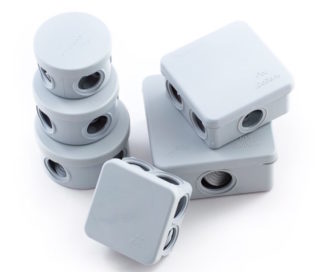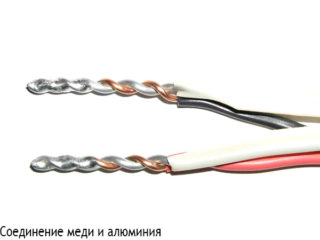Indoor wiring can be carried out in two ways - open and closed. Open wiring is the easiest to install and lay electrical lines. It does not require wall chamfering, so you can lay cables in this way after construction work. Open wiring is used infrequently. It can disrupt the interior of the room, therefore, they prefer to conduct conductors with an external type in certain areas. Installation is simple and does not take much time, but certain rules must be followed.
Primary requirements

Carrying out electrical wiring is a process during which all the nuances must be observed. Deviation from the rules can lead to an emergency and fire hazardous situation.
The basic rules are:
- Do not install the outdoor cable under a pipeline that collects condensation.
- Heat radiators should not be located in the area with cables.
- It is recommended to lay cables with additional protection. The choice of the type of conductor (rigid, screened, flexible) is determined by the operating and application conditions.
- If the wiring is installed in plumbing niches, no junction boxes need to be used.
- The cores of the cables are connected to each other only in special distribution boxes.
- The distribution board should be located in such a place that the master, if necessary, has easy access to it. In the case of use in a humid room, gaskets are installed on the lid for additional tightness.
Before installation, the wires must be visually checked. They must be free of damage, kinks, insulation breakdown along the entire length up to connection to an outlet, switch and other power points.
Installing the cable
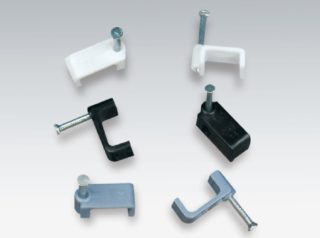
The conductor is fastened using plastic brackets. They are purchased together with a cable according to its diameter. There should not be a large distance between the fixing mechanisms, since then the wire will sag. Clamps are placed on both sides of the cable and near the points of connection to the elements. When laying the telephone and electrical wires horizontally, the staples are placed one above the other at a distance not exceeding 40 cm. If the conductor is armored, the minimum distance is increased to 75 cm. In the case of vertical wiring, the interval between the fixing devices does not exceed 1 m.
Conventional conductors with protection in a horizontal position require staples to be located at a distance of no more than 25 cm, in a vertical position - no more than 40 cm.The interval between the clamp and the electrical element to which the cable is connected should not be more than 10 cm.
The line of force can cross a non-electrical conduit. In this case, there should be a minimum interval of 3 cm between them. You can bend the conductors with the smallest radius of 8 cm.
Advantages and disadvantages of open wiring
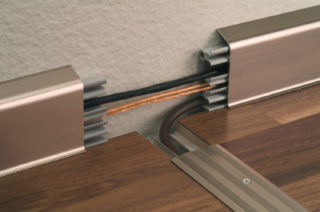
The open method of wiring installation has its advantages and disadvantages. The advantages include the following factors:
- Ease of installation.
- The integrity of the walls and ceiling is not violated, since they do not need to be channeled.
- Possibility of conducting electrical wiring after construction work during finishing.
- No need to buy additional hardware.
- Easy to replace wires and batteries in case of breakage.
- Cheapness. The electrician will charge less for the installation of exposed wiring.
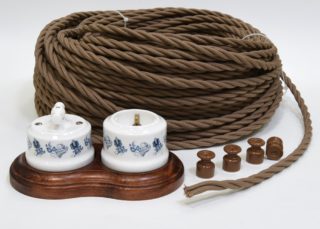
Minuses:
- Unattractive appearance. Vintage wire is not suitable for all interiors. Most often used in loft, retro, steampunk rooms. The help of a professional designer may be required to create a beautiful look.
- Required to take into account the technical standards of the room
- Risk of damage to the electrical cable, especially if it is not protected by a corrugated pipe or back box.
- High fire hazard.
- The need for protection from external influences (temperature, UV, moisture). Especially important when bringing wires to the street.
After studying the advantages and disadvantages of open wiring, as well as its features, the owner of the house decides whether to choose it or it is better to give preference to hidden installation. You should also decide: the work will be carried out independently or with the call of an electrician.
The main methods of surface mounting
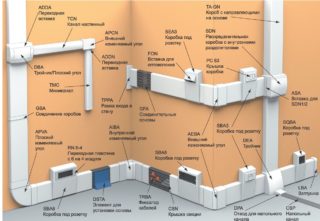
Previously, the installation of open wiring was carried out only by attaching it to the walls and ceiling on ceramic insulators. Now there are more ways, and the main ones include:
- Mounting on buttons or brackets. The wires are fixed on the wall using special brackets at a certain distance from each other. Metal strips are commonly used. This is the cheapest and easiest way to manage your cables. Disadvantages - insecurity and unattractive appearance.
- Installation in pipes. Cables are placed in special electrical pipes made of metal and plastic. They reliably protect the conductor from fires and mechanical damage. In wooden houses, it is better to use a corrugated pipe. The diameter of the purchased tube depends on the total thickness of all the conductors that will be laid in it. When creating a diagram, it is important to think over the location so that the pipes do not intersect or intersect.
- Gasket in boxes. For this, durable electrical boxes, cable ducts or skirting boards are used. Such structures cannot be placed on uneven walls, unlike corrugated pipes. There are different types of boxes, the choice of which depends on the type of room, type of walls, operating conditions and other indicators. These frame boxes are equipped with snap-on covers for easy opening and removal. They have a stylish design (semi-antique, retro), different colors (black, white, colored) and are easy to install sockets and switches.
All described installation options have a similar installation algorithm. The difficulty is also about the same in all cases.
Installation technology
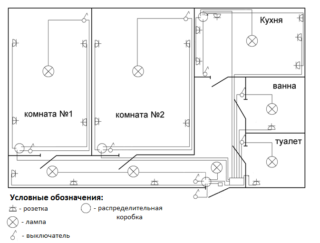
Installation of electrical wiring in an open way is carried out according to the following algorithm:
- Project creation. The number and location of outlets, switches, boxes and other items are determined.
- Purchase of relevant materials. They must be suitable in terms of performance, safety requirements, room decor, and be antistatic. Retro twisted wire can be used depending on the interior design. Outdoor products must be adequately protected.
- Fastening boxes.
- Wiring. The twisted wire is either placed in the housings or fixed with staples, depending on the method chosen.
The last step is to supply electricity and check the functionality.
Be sure to pay attention to the choice of base material. The choice of fastening devices depends on it.The boxes are fastened to wood with screws, to brick or concrete - to dowels, panels and slabs - butterfly fasteners.
Common mistakes
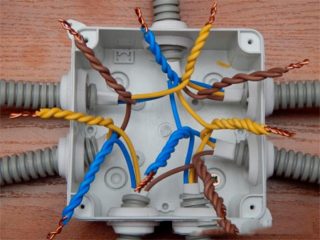
External wiring is easier than closed wiring, but craftsmen make a number of common mistakes. The most popular are the following:
- Lack of a structured scheme. If you do not think in advance about the internal wiring of a twisted cable for open wiring, the reliability and convenience of the entire assembled system decreases.
- Selection of low-quality materials. Safety in the house directly depends on the quality of wires and boxes, so it is important to give preference to proven products. You can buy everything in a professional store of building materials and electrical appliances. You should choose well-known brands that are responsible for the quality of the goods and have the appropriate licenses.
- Purchase of wires without taking into account the stock. An incorrect calculation of the cross-section of an electric cable for outdoor installation without an addition of 20% can threaten overloads and fire.
- Connecting powerful electrical appliances to a common outlet, and not through a separate cable. Even with a professional power outlet, the wiring may not be able to handle the load.
The combination of copper and aluminum leads to rapid corrosion of metals - Twisted wire connection. This method is strictly prohibited by PUE, so it is better to use terminals.
- Contact of copper and aluminum wires. These materials have different properties, so if you try to connect them, the contact will be unreliable and quickly break down.
- Wrong location of junction boxes. They are placed 20 cm below the ceiling to reduce the risk of accidental damage.
- Lack of grounding.
- Installation of sockets and switches in places where it is difficult to reach the hand of any tenant of the apartment.
Compliance with safety measures and strict adherence to the installation algorithm will help the master to make a safe and beautiful outdoor electrical wiring in the house.

